TL;DR:
- British Defense Ministry unveils two cutting-edge AI initiatives.
- Landmark beach-landing exercise in the English Channel showcases AI’s role in defense.
- Motherlode software revolutionizes helicopter maintenance, predicting equipment failures with remarkable accuracy.
- The AI journey continues with potential applications across various defense equipment.
- A transformative era of AI-powered capabilities is set to reshape global security.
Main AI News:
In the ever-evolving landscape of defense technology, the British Defense Ministry has taken the lead by divulging the intricacies of two groundbreaking artificial intelligence (AI) ventures. As the world gears up for a global summit dedicated to addressing the challenges posed by AI, these revelations are set to make waves.
Commencing on November 1st at the historic World War II code-breaking center at Bletchley Park, the two-day summit is slated to host a distinguished gathering of global leaders. Notable attendees include the UK’s Prime Minister, Rishi Sunak; US Vice President Kamala Harris; European Commission President Ursula von der Leyen; and UN Secretary-General Antonio Guterres, alongside influential figures from the tech industry.
Charting New Horizons at Sea
On October 31st, the British Defense Ministry announced a significant milestone – a beach-landing exercise conducted in the English Channel, off the coast of Hampshire. This ambitious undertaking was orchestrated by the Defense Science and Technology Laboratory, in collaboration with the Royal Navy and Army. Held over five days in September, it featured a cadre of approximately 130 personnel, 13 vessels, multiple Unmanned Aerial Vehicles (UAVs), a light aircraft, and over 50 cameras and sensors, all deployed to amass critical data that holds the potential to revolutionize defense through AI.
The participation of several US government organizations, including the Air Force Research Laboratory’s Munitions Directorate and the Department of Energy’s Pacific Northwest National Laboratory, underscored the global significance of this endeavor. Additionally, industry giants such as BAE Systems, Chess Dynamics, Leonardo, Lockheed Martin, and Thales lent their expertise to the project.
The beach landing exercise was a multifaceted endeavor, with personnel executing various scenarios to capture data representative of diverse behavioral traits. From synchronized landings that mimicked military precision to deliberate chaos that replicated unpredictable human movement, this exercise showcased the adaptability of AI in the defense realm. Minister for Defense Procurement James Cartlidge affirmed, “Innovative, data-driven exercises like this demonstrate how AI can enhance our military capabilities, enabling us to respond more efficiently to the threats of today and tomorrow.”
The data harvested during this operation, spanning visual, infrared, sonar, radar information, as well as metadata like platform and sensor locations, weather conditions, and sea states, will serve as the bedrock for training AI algorithms. These algorithms will be engineered to identify objects, including other vessels, offering a substantial leap forward in defense technology.
Revolutionizing Helicopter Maintenance
In addition to the ambitious beach-landing exercise, the Ministry of Defense also provided insights into a groundbreaking AI-driven software tool. Named “Motherlode,” this software harnesses AI’s power to revolutionize maintenance and enhance availability.
Motherlode possesses the capability to analyze historical data tailored to environmental and aircraft-specific conditions, thereby predicting equipment failures with unparalleled accuracy. What used to be a time-consuming problem-solving task now takes mere seconds. The Ministry of Defense anticipates a full rollout of this game-changing technology across all Royal Navy helicopters, encompassing the Wildcat and Merlin fleets, by the year’s end.
Commander Nicholas Almond, who leads the 1710 Naval Air Squadron of the Royal Navy’s Fleet Air Arm, declared, “This is just the beginning of the AI journey for the Fleet Air Arm. There are multiple use cases being explored, leveraging AI to enhance our data exploitation capabilities to maximize aircraft availability for frontline operations.“
Not content to rest on its laurels, the Ministry of Defense is actively exploring the potential deployment of AI technology across other defense equipment, with the Foxhound armored patrol vehicle standing as a prime candidate for transformation. The future of defense is unfolding before our eyes, ushering in a new era of AI-powered capabilities that promise to reshape the landscape of global security.
Conclusion:
The British Defense Ministry’s unveiling of pioneering AI initiatives marks a significant leap forward in the realm of defense technology. From data-driven beach-landing exercises to revolutionary predictive maintenance software, these advancements promise to enhance military capabilities and readiness. As AI continues to make inroads across defense equipment, the market can anticipate a growing demand for AI-driven solutions and technologies in the defense sector, fostering innovation and strategic adaptability.

